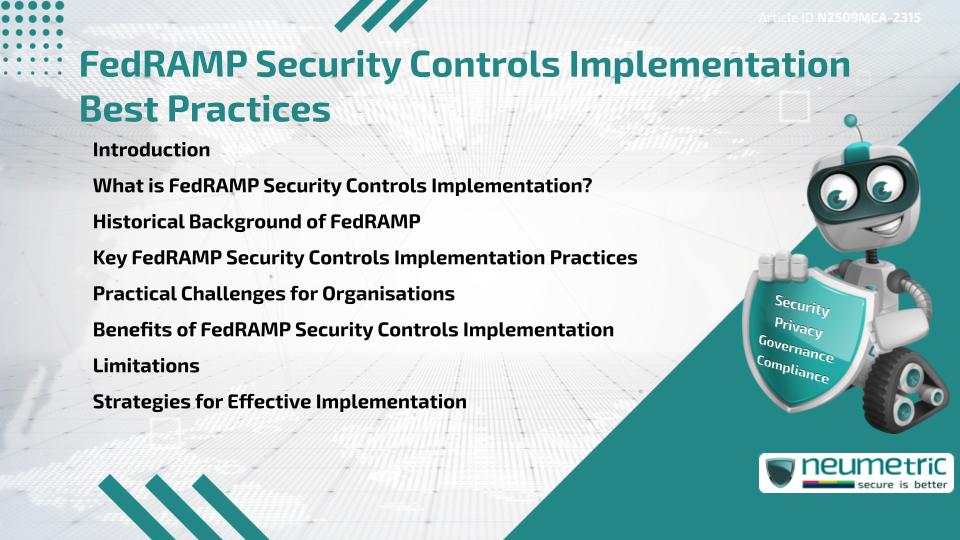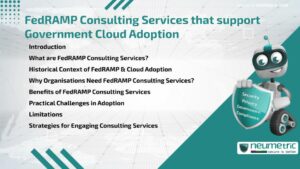Table of Contents
ToggleIntroduction
FedRAMP Security Controls implementation is a vital step for Cloud Service Providers & Federal Contractors aiming to work with U.S. Government Agencies. The Federal Risk & Authorization Management Program [FedRAMP] Standardises Cloud Security, ensuring consistent protection of Federal Data. For Organisations, implementing these Security Controls means balancing Regulatory Compliance with Operational efficiency.
What is FedRAMP Security Controls Implementation?
FedRAMP Security Controls implementation refers to the process of applying the required Safeguards outlined in the FedRAMP Framework. Based on the NIST 800-53 guidelines, the Program mandates Controls across areas such as Access Management, Incident Response & Data Protection. Compliance ensures Cloud Systems meet Federal Security requirements, enabling Providers to earn Authorisation to operate.
Historical Background of FedRAMP
FedRAMP was introduced in 2011 to address growing concerns about Cloud adoption in Government Operations. Before FedRAMP, agencies relied on fragmented Security Assessments, Creating Inefficiencies & Risks. The Program centralised the process, providing a unified Standard for assessing & monitoring Cloud Security. Over time, it has become mandatory for Cloud Service Providers seeking Federal Contracts.
Key FedRAMP Security Controls Implementation Practices
Enterprises must focus on several areas to achieve Compliance:
- Access Controls: Implement Least-privilege Policies & Multi-factor Authentication.
- Data Protection: Encrypt Sensitive Data at Rest & In Transit.
- Continuous Monitoring: Track System Performance & Vulnerabilities in real time.
- Incident Response: Establish Plans for detecting & responding to Breaches.
- Audit & Reporting: Maintain documentation for Regular Reviews & Authorisations.
Detailed Resources are available from the FedRAMP Program Office.
Practical Challenges for Organisations
FedRAMP implementation can be Resource intensive. Smaller Providers may struggle with Costs of Audits, Continuous Monitoring & Dedicated Compliance staff. Integrating controls into Legacy Systems or Hybrid Environments also poses Technical challenges. Additionally, the Authorisation process can take months, delaying Time-to-market for Cloud Solutions.
Benefits of FedRAMP Security Controls Implementation
Despite these challenges, Compliance provides clear advantages:
- Access to Federal Contracts & Broader Market opportunities
- Stronger Security Posture through Structured Controls
- Increased trust from Government & Private Sector Clients
- Streamlined Risk Management with Centralised monitoring
- Competitive advantage for Providers that achieve Certification
Limitations
Critics argue that FedRAMP requirements may be overly complex & burdensome, especially for Startups or Smaller Providers. Some also note that strict Controls may limit Innovation & Flexibility. Compliance does not guarantee immunity from Cyberattacks but significantly reduces Risks.
Strategies for Effective Implementation
To succeed with FedRAMP Security Controls implementation, Organisations should:
- Begin with a Readiness Assessment to identify Gaps
- Engage with experienced Third Party Assessment Organisations [3PAOs]
- Automate monitoring & reporting processes where possible
- Train Employees on Compliance Responsibilities & Incident Response
- Reference Frameworks from NIST, OECD Governance guidelines & World Bank insights for broader Governance Practices
Takeaways
FedRAMP Security Controls implementation is more than a Compliance Exercise, it is a Strategic step in securing Cloud Environments & Earning Trust. Organisations that embed Best Practices into daily Operations can achieve Authorisation, reduce Risks & Enhance Competitiveness.
FAQ
What is FedRAMP Security Controls implementation?
It is the process of applying required Security Safeguards to meet FedRAMP Compliance for Cloud Services.
Why is FedRAMP important for Organisations?
It standardises Cloud Security for Federal agencies & is mandatory for Providers seeking Government Contracts.
What challenges are common in implementation?
High costs, complex Technical Integration & Lengthy Authorisation Processes.
What are Key practices for Compliance?
Access Controls, Encryption, Continuous Monitoring, Incident Response & Audit Readiness.
Does Compliance guarantee complete Security?
No, but it reduces Risks significantly & improves Overall Governance.
References
- FedRAMP Program Office
- NIST CyberSecurity Framework
- OECD Privacy Guidelines
- World Bank Digital Development
- ENISA – European Union Agency for CyberSecurity
Need help for Security, Privacy, Governance & VAPT?
Neumetric provides Organisations the necessary help to achieve their CyberSecurity, Compliance, Governance, Privacy, Certifications & Pentesting needs.
Organisations & Businesses, specifically those which provide SaaS & AI Solutions in the Fintech, BFSI & other regulated sectors, usually need a CyberSecurity Partner for meeting & maintaining the ongoing Security & Privacy needs & requirements of their Enterprise Clients & Privacy conscious Customers.
SOC 2, ISO 27001, ISO 42001, NIST, HIPAA, HECVAT, EU GDPR are some of the Frameworks that are served by Fusion – a SaaS, multimodular, multitenant, centralised, automated, CyberSecurity & Compliance Management system.
Neumetric also provides Expert Services for Technical Security which covers VAPT for Web Applications, APIs, iOS & Android Mobile Apps, Security Testing for AWS & other Cloud Environments & Cloud Infrastructure & other similar scopes.
Reach out to us by Email or filling out the Contact Form…





